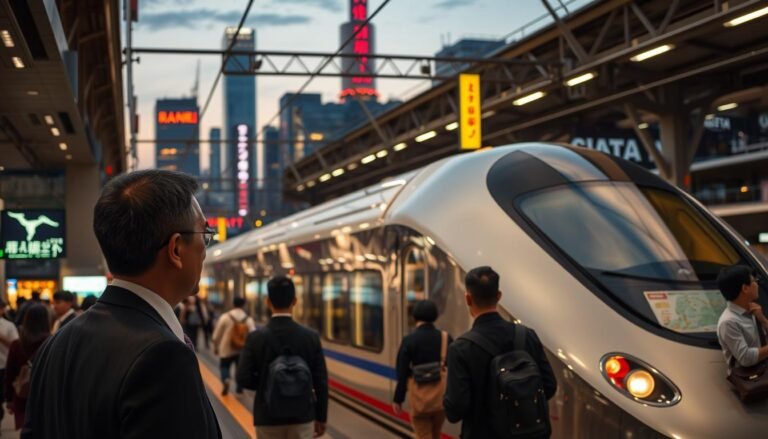Imagine walking under pink cherry blossoms in spring or enjoying hot tea with snow-covered temples in winter. Japan changes with each season, giving travelers a new view every time. From tropical beaches to snowy mountains, each area is best at different times, making when you go very important.
Are you into autumn leaves in Kyoto or summer festivals in Osaka? Knowing Japan travel seasons reveals secret spots. Coastal towns are full of seafood festivals after cherry blossoms, and Hokkaido is a winter wonderland. Japan’s varied landscapes mean you can find perfect weather anytime.
This guide shows you the best places for each season. Find wisteria tunnels, lakeside fireworks, golden rice fields, and ice hotels. Let’s explore seasonal Japan and plan your trip with nature’s calendar!
Key Takeaways
- Japan offers distinct attractions each season, from cherry blossoms to snow festivals
- Regional climate variations allow year-round travel opportunities
- Seasonal festivals highlight local culture and traditions
- Advance planning ensures optimal weather and fewer crowds
- Transportation passes simplify exploring multiple regions
- Seasonal cuisine enhances cultural immersion
Understanding Japan’s Seasonal Magic
Japan’s weather changes are more than just weather. They are cultural events that are part of the country’s identity. From cold Hokkaido to warm Okinawa, the weather influences festivals, food, and more.
Why Season Dictates Your Japanese Adventure
Traveling in Japan changes a lot depending on the season and location. In February, you might ski in Nagano or enjoy the beach in Okinawa. Both are winter, but they feel very different.
Microclimates from Hokkaido to Okinawa
Japan’s climate diversity makes each region unique:
| Region | Winter Temps | Summer Temps | Seasonal Highlight |
|---|---|---|---|
| Hokkaido | 14°F (-10°C) | 75°F (24°C) | Ice festivals |
| Tokyo | 41°F (5°C) | 86°F (30°C) | Cherry blossoms |
| Okinawa | 64°F (18°C) | 88°F (31°C) | Coral spawning |
Traveling in Japan means packing for different climates. In Hokkaido, it’s snowy onsen, while Kyoto is hot and humid. Locals plan trips based on the season, just like chefs choose ingredients.
Cultural Connections to Nature’s Calendar
Shinto traditions link festivals to the seasons. The Aomori Nebuta Matsuri in August celebrates rice planting. Today, it’s a colorful festival, but it started as a prayer for a good harvest.
Three key seasonal experiences for travelers:
- Spring hanami parties under cherry blossoms
- Autumn moon-viewing rituals
- Winter onsen visits for “snow viewing baths”
Knowing Japan’s weather and traditions helps avoid crowds. Why fight the cherry blossom crowds in Kyoto when you can see plum blossoms in February?
Best Cities to Visit in Japan by Season: A Year-Round Guide
Japan’s cities change with the seasons, showing off natural beauty and culture. You can see cherry blossoms or winter landscapes at their best. This guide helps you find the right place at the right time.
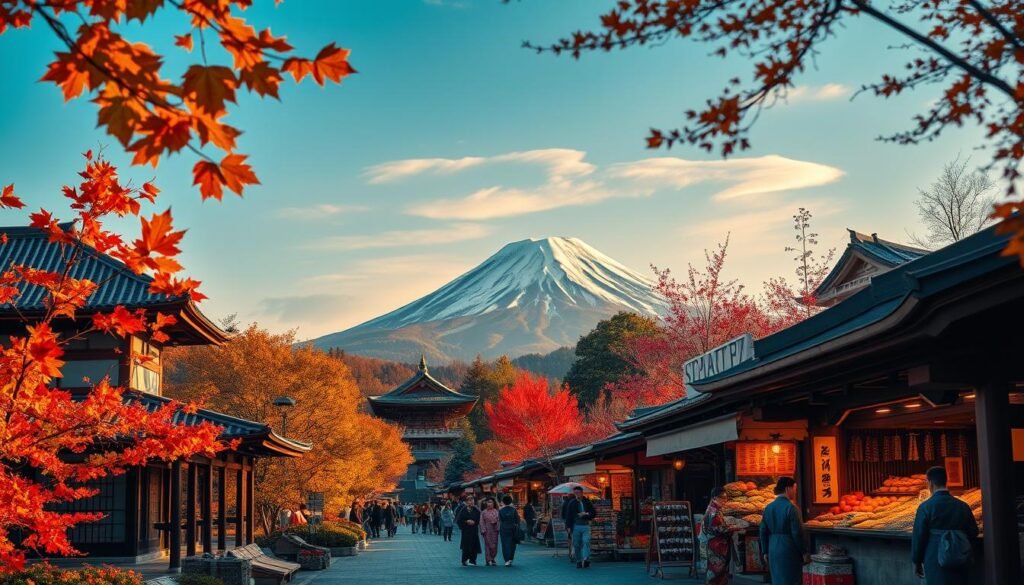
Spring’s Cherry Blossom Circuit
When spring comes, two places are must-sees for different experiences.
Kyoto: Philosopher’s Path Perfection
The Philosopher’s Path turns pink in hanami season. It’s lined with stone lanterns and temples. Get there early to avoid the crowds.
Hirosaki: Northern Frontier of Sakura
Hirosaki Castle Park blooms later (late April to early May). It’s great for those missing Kyoto. The castle and night lights are magical, and the “petal carpet” is unforgettable.
Summer Festival Hotspots
Summer in Japan is full of festivals for cultural fun.
Tokyo: Fireworks Over Sumida River
The Sumida River Fireworks Festival lights up July. Get a riverside spot early or try a yakatabune dinner. Visit Senso-ji Temple at night too.
Aomori: Nebuta Matsuri Fever
Aomori’s parade in early August features giant paper floats. The floats move through streets with dancers. Try miso-curry milk ramen between float views.
Autumn’s Crimson Corridors
Autumn in Japan means chasing koyo (red leaves) through stunning landscapes.
Nikko: World Heritage Maple Majesty
Nikko’s UNESCO sites are set against fiery maples in mid-October. The Sacred Bridge is stunning. Hike the Kanmangafuchi Abyss trail for unique views.
Hakone: Fuji-Adorned Foliage
Hakone offers autumn colors and Mount Fuji views. The Hakone Ropeway gives dual views of forests and Fuji. Lake Ashi’s reflection is perfect on clear days.
Winter Wonderland Escapes
Japan’s winter turns cities into snowy playgrounds.
Sapporo: Ice Festival Extravaganza
Sapporo’s February Ice Festival has giant snow sculptures lit up. Odori Park and Susukino area show off ice art. Warm up with soup curry at ramen alley.
Nagano: Powder Snow Paradise
Nagano’s Hakuba Valley has top-notch skiing. Non-skiers can see snow monkeys or explore Zenko-ji Temple. December-March has the deepest snow.
Spring in Japan (March-May): When Cherry Blossoms Paint the Nation Pink
As winter’s chill fades, Japan turns into a pastel wonderland. Spring flower viewing becomes a national obsession. Travelers chase the sakura zensen (cherry blossom front) across the archipelago. They discover unique regional traditions beneath the blooming boughs.
Kyoto’s Hanami Hierarchy
Japan’s ancient capital offers timeless spring in Japan experiences. Cherry trees frame historic temples like natural picture frames.
Maruyama Park Night Illuminations
Kyoto’s largest weeping cherry tree becomes a glowing centerpiece after dark. Local vendors sell hanami dango (sweet rice dumplings) to enjoy under the illuminated blossoms.
Arashiyama Bamboo Grove Blooms
The famous bamboo forest’s lesser-known cherry groves offer serene morning walks. Early birds can photograph pink petals dusting the bamboo pathway before crowds arrive.
Tokyo’s Blossom Boomtowns
Japan’s modern metropolis contrasts Kyoto’s traditional charm with vibrant urban spring flower viewing culture.
Ueno Park Picnic Culture
Over 1,000 trees create Tokyo’s most energetic hanami scene. Office workers and families alike claim spots with blue tarps, sharing bento boxes and sake.
Meguro River Canal Strolls
Four-kilometer cherry tree tunnels reflect perfectly in the canal’s waters. Evening boat tours offer unique perspectives of the floating petals.
Offbeat Spring Alternatives
Escape the crowds at these hidden gems. They offer unconventional spring in Japan experiences.
Shikoku’s Yoshino River Valley
Over 30,000 cherry trees line this 12km riverside stretch. Local fishermen offer sakura-viewing boat rides through petal-filled waters.
Tohoku’s Fruit Blossom Trails
Apple and peach orchards bloom in colorful succession through April. Many farms offer blossom-themed treats like apple blossom honey ice cream.
“Check the Japan Meteorological Corporation’s cherry blossom forecast Japan reports weekly. Bloom times can shift by 5-10 days annually.”
| Location | Peak Bloom Period | Best Spot | Unique Feature |
|---|---|---|---|
| Kyoto | Late March | Philosopher’s Path | Temple views |
| Tokyo | Early April | Chidorigafuchi Moat | Rowboat access |
| Yoshino Valley | Mid-April | Senbonzakura Grove | Mountain backdrop |
Pro tip: Many regional festivals coincide with full bloom periods. Aomori’s Hirosaki Castle Festival (April 23-May 5) features night illuminations and samurai parades beneath the blossoms.
Summer in Japan (June-August)
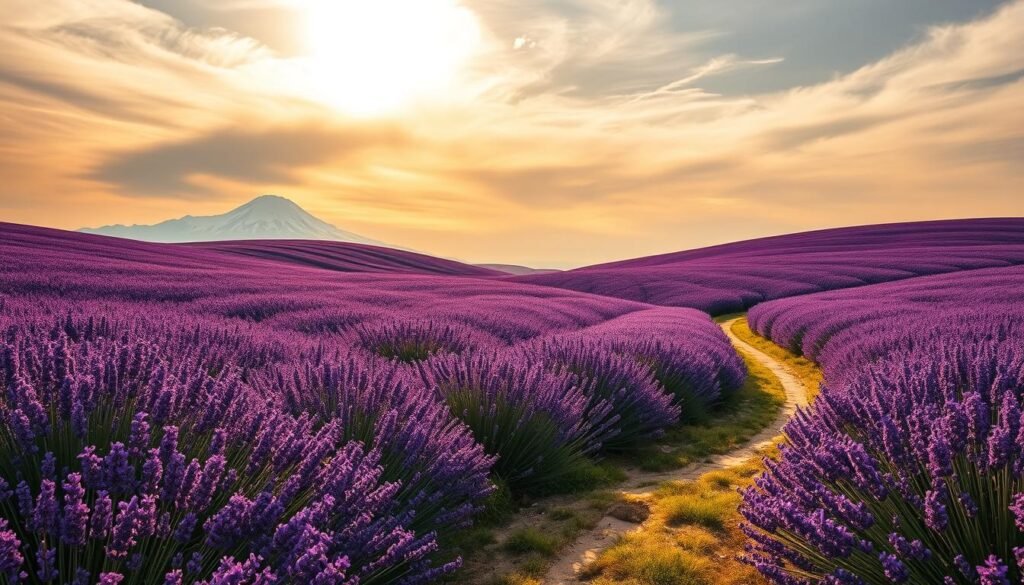
Japan’s summer is a mix of hot cities and cool natural spots. June is humid, but July and August bring festivals and beach fun. Travelers can enjoy both the heat and the coolness with some planning.
Hokkaido’s Cool Summer Oasis
Hokkaido is cool and mild, unlike the hot cities. Its rainy season is shorter, making it great for exploring early summer.
Lavender Fields of Furano
- Peak blooms: Mid-July to early August
- Must-see farms: Farm Tomita’s rainbow flower strips, Choei Lavender Farm’s hilltop views
- Pro tip: Try Furano’s melon ice cream for a special treat
Rebun Island Hiking Trails
Rebun Island is a 50-mile floral paradise north of Hokkaido. It offers:
- 8-hour “Flower Route” hike through 300+ Arctic-alpine species
- Dramatic sea cliffs cooled by Okhotsk Sea breezes
- Overnight stays in traditional minshuku guesthouses
Kyushu’s Beachfront Bliss
Kyushu has a tropical climate and volcanic landscapes. It’s perfect for those who love:
- Warm waters (75-82°F) from June onward
- Unique black-sand beaches
- Island-hopping flexibility
Kagoshima’s Volcanic Coastlines
Sakurajima volcano creates amazing swimming spots:
- Nagisa Lava Trail’s heated foot baths
- Kurokami Buried Shrine Gate – half-submerged by 1914 eruption
- Ferry-accessible hot sand baths at Ibusuki Onsen
Okinawan Island Hopping
- Best for snorkeling: Kerama Islands’ 50m visibility waters
- Culture meets beach: Taketomi Island’s traditional Ryukyu houses
- Festival highlight: July’s Eisa Dance Festivals on main island
Mountain Retreats
Japan’s mountains are cooler and less crowded. They offer a peaceful escape from the city heat.
Kamikochi Alpine Escapes
- Open May-November in Chubu Sangaku National Park
- Car-free hiking among 10,000ft peaks
- Stay at historic Kamikochi Imperial Hotel
Koyasan Temple Stay Cool
- Overnight in UNESCO-listed Shukubo lodgings
- Participate in morning Buddhist rituals
- Walk ancient cedar paths to Okunoin Cemetery
“Hiking Kamikochi in August feels like stepping into a Bob Ross painting – happy little clouds, majestic pines, and crystal streams everywhere.”
Balance beach days with mountain retreats. Wear quick-dry clothes and carry a fan for city trips.
Autumn in Japan (September-November)
As summer’s heat fades, Japan turns into a canvas of fiery reds and golden yellows. This offers some of the world’s most stunning autumn vistas. The koyo (foliage) season moves southward from Hokkaido in September to Kyushu by late November. This creates a dynamic travel window.
Urban parks glow with evening illuminations. Ancient pilgrimage trails become corridors of color. These are perfect for travelers craving both culture and wilderness.
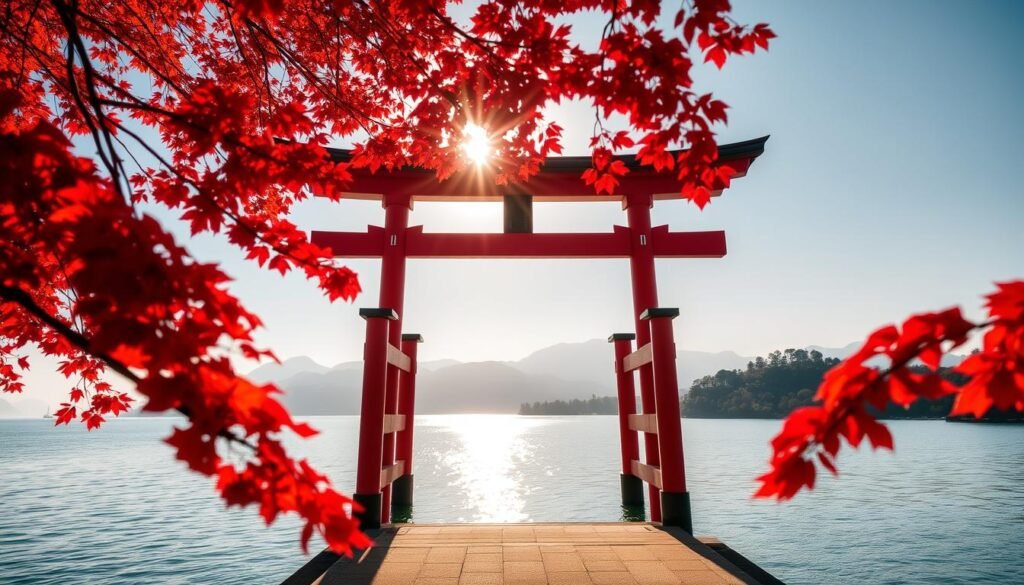
Koyo Classics
Japan’s most iconic autumn scenes blend natural beauty with cultural landmarks. These destinations showcase foliage at its peak. The timing varies by latitude and elevation.
Miyajima’s Floating Maple Scapes
The crimson gates of Itsukushima Shrine appear to float among maple-covered hills during autumn. Local guides recommend visiting mid-November. This is when:
- Peak foliage coincides with lower tides
- Evening illuminations reflect on the Seto Inland Sea
- Momiji manju (mapleaf-shaped cakes) warm chilly hands
Lake Towada Dual Crater Beauty
Northern Honshu’s volcanic lake offers double the drama:
- Hike Oirase Gorge’s mossy waterfalls framed by gold-bronze beech trees
- Cruise the lake to see mirrored autumn peaks in calm waters
- Stay through October for the Towada Autumn Festival’s firelit processions
“Autumn in Japan isn’t just a season—it’s a daily art exhibition where nature herself paints the galleries.”
Urban Autumn
Japan’s cities offer sophisticated seasonal displays. These metropolitan highlights prove you don’t need forests to experience fall magic.
Osaka Castle Park Illuminations
The historic fortress becomes a luminescent wonderland after dark:
- 3,000 paper lanterns trace castle walls
- Projection mapping shows samurai-era autumn scenes
- Food stalls serve persimmon kakigori (shaved ice)
Yokohama Harbor Night Views
Minato Mirai’s skyscrapers frame unique autumn moments:
- Ride the Cosmo Clock 21 Ferris wheel over glowing ginkgo boulevards
- Attend the Yokohama Oktoberfest with local craft beers
- Capture the Osanbashi Pier sunrise through crimson maple branches
Pilgrimage Pathways
Ancient trails offer moving meditations on seasonal change. These routes combine fall hiking Japan opportunities with spiritual discovery.
Kumano Kodo Forest Canopies
The UNESCO World Heritage trail becomes a tunnel of color:
- Late October brings peak hues to cedar forests
- Stay in pilgrim lodges for chestnut rice and mushroom hot pots
- Attend fire rituals at Nachi Falls’ vermilion pagoda
Shikoku 88 Temple Transition
Circumnavigate the island as leaves change:
- Start at Ryozenji Temple (Sept) with early-turning maples
- Reach Kochi’s fiery momiji valleys by early November
- Complete the journey under golden ginkgos at Okuboji (late Nov)
| Location | Experience | Best Time | Highlights |
|---|---|---|---|
| Miyajima | Coastal Foliage | Mid-Nov | Floating torii illuminations |
| Osaka Castle | Urban Light-Up | Late Nov | Samurai-era projections |
| Kumano Kodo | Forest Hike | Late Oct | Cedar canopy trails |
| Shikoku Route | Temple Pilgrimage | Sept-Nov | 88 seasonal transitions |
Whether chasing the perfect maple photo or seeking quiet forest paths, Japan’s autumn delivers unforgettable moments. Regional festivals by season add cultural depth to every crimson vista. From samurai reenactments under Osaka’s castle maples to Shikoku’s temple bell ceremonies echoing through golden valleys.
Winter in Japan (December-February)
Japan turns into a snow-globe paradise in winter. It offers world-class skiing and steamy hot spring retreats. You can carve fresh powder or wander through lantern-lit streets covered in snow. The colder months show a quieter, more contemplative side of Japanese culture.
Ski Capital Showdown
Japan’s ski resorts are as good as those in the Alps. They have legendary snow quality and unique après-ski culture. Two places stand out for different experiences:
Niseko’s Champagne Powder
Niseko on Hokkaido Island has dry, fluffy snow. Skiers say it’s like “riding through clouds.” The resorts of Grand Hirafu and Hanazono offer:
- Night skiing under illuminated slopes
- English-speaking ski schools
- Natural hot springs at base areas
Hakuba Olympic Slopes
Hakuba Valley in Nagano Prefecture was the site of the 1998 Winter Olympics. It offers challenging terrain and cultural immersion. Don’t miss:
- Backcountry tours to sacred mountain shrines
- Traditional sake tastings at slope-side huts
- Easy access to Jigokudani Snow Monkey Park
| Feature | Niseko | Hakuba |
|---|---|---|
| Annual Snowfall | 50+ feet | 35 feet |
| Best For | Powder enthusiasts | Terrain variety |
| Cultural Bonus | Ainu heritage sites | Samurai history museums |
Onsen Snowscapes
Soaking in mineral-rich hot springs is perfect after a day in the snow. These two places offer different thermal experiences:
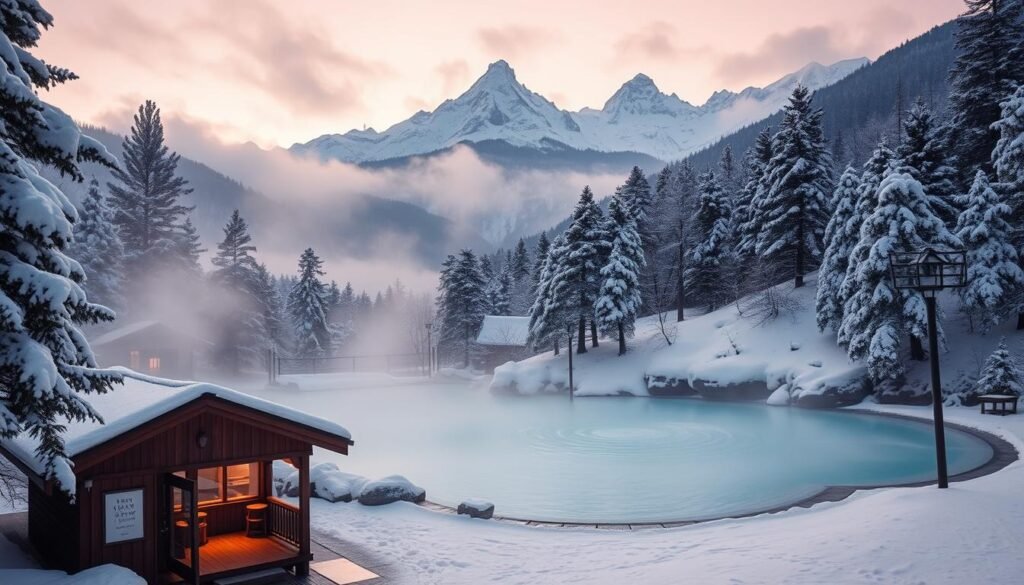
This Taisho-era village in Yamagata Prefecture looks like a Studio Ghibli film. Wooden ryokans with cascading rooflines line a frozen river. It’s lit up at night by gas lamps. Stay at Nishimuraya Honkan for kaiseki meals featuring winter delicacies like snow crab.
Yuzawa Snow Monkey Adjacents
Yuzawa is 75 minutes from Tokyo. It’s a gateway to skiing and primate encounters. After skiing at Gala Yuzawa, visit Jigokudani Monkey Park to see macaques in outdoor onsens.
Winter Festivals Deep Dive
Japan’s cold months spark creative celebrations. They blend ancient traditions with modern artistry.
Sapporo Snow Festival Must-Sees
Hokkaido’s capital turns into an ice sculpture wonderland in February. Top highlights include:
- Life-sized replicas of global landmarks
- LED-lit ice slides for adults
- Seafood stalls serving grilled scallops on shell
Kamakura Igloo Dining
In Akita Prefecture, the Yokote Kamakura Festival lets visitors:
- Dine on mochi soup inside snow huts
- Write wishes on paper lanterns
- Photograph thousands of miniature snow domes
From the crunch of ski boots on fresh powder to the hiss of steam from open-air baths, Japan’s winter wonderlands create lasting memories.
Japan’s Climate Decoder
Japan’s landscapes are full of contrasts. Imagine snow-covered mountains and sunny citrus groves side by side. This climate variation across Japan makes planning trips a strategic game. Knowing the regional patterns helps make better travel choices.
Sea of Japan vs Pacific Patterns
The Japanese Alps divide Japan into two climate zones. On the Sea of Japan side, winter turns places like Niigata into snow country with lots of powder. This is great for skiing but tough for driving.
The Pacific coast has drier winters. But summer brings hot, humid weather that makes Tokyo feel like a tropical place.
| Region | Winter | Summer |
|---|---|---|
| Sea of Japan Coast | Heavy snowfall | Mild temperatures |
| Pacific Coast | Dry & sunny | Hot & humid |
Typhoon Season Realities
September is the peak time for typhoons, with 11 storms hitting Japan on average. Okinawa and Kyushu are most affected, but Tokyo also sees 2-3 major storms each fall. Typhoon season travel needs careful planning:
- Book refundable accommodations mid-August to October
- Pack waterproof gear and backup power banks
- Download Japan’s Safety Tips App for real-time alerts
Travelers can use typhoon days to visit indoor attractions. Think Osaka’s Cup Noodle Museum or Kyoto’s traditional machiya houses. Most storms last only 24 hours, so being flexible is key to enjoying Japan’s climate guide.
Packing Smart: Seasonal Survival Kits
Japan’s weather changes a lot, so you need to pack smart. Your bag should handle hot and cold weather well. We’ll show you what to pack for summer and winter, keeping your bag light.
Summer Humidity Hacks
Tokyo in August is like walking in miso soup. Moisture-wicking fabrics are a must. Polyester blends with mesh panels beat cotton, which holds sweat. Here are three must-haves:
- Quick-dry polo shirts (perfect for temple visits)
- UPF 50+ parasols that also keep you dry in the rain
- Portable neck fans that charge via USB
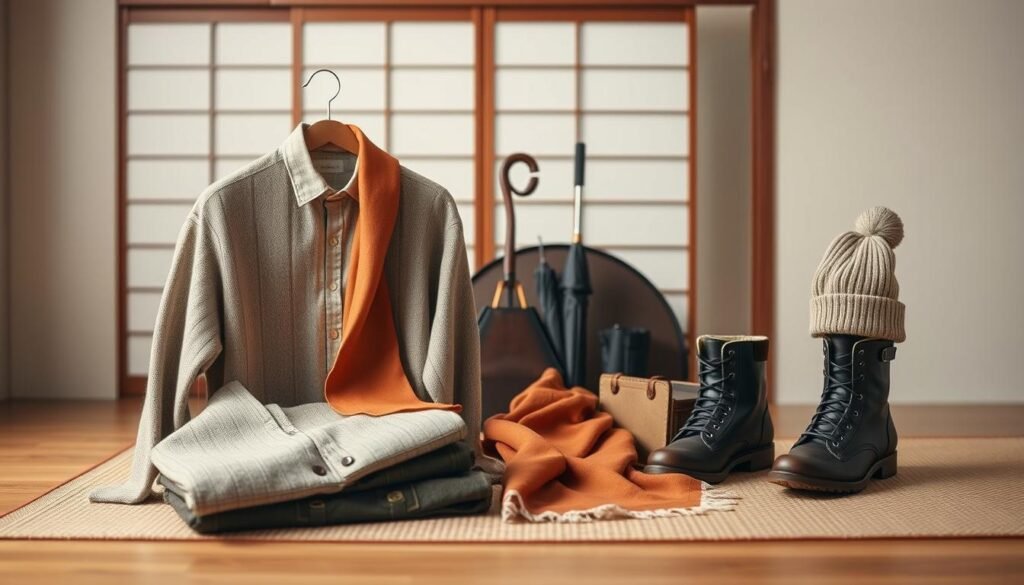
| Fabric Type | Dry Time | Best For |
|---|---|---|
| Linen | 25 minutes | Coastal areas |
| Merino Wool | 40 minutes | Mountain regions |
| Polyester Tech | 12 minutes | City exploration |
Winter Layer Formulas
Hokkaido gets very cold, so layering is key. Use the 3-2-1 system for the best results:
- Base layer: Silk or synthetic thermal top
- Mid layer: Fleece or thin down jacket
- Outer shell: Waterproof ski jacket
| Layer Type | Key Feature | Temp Range |
|---|---|---|
| Uniqlo Heattech | Moisture control | 32°F to 50°F |
| Patagonia Nano Puff | Compressible | 10°F to 30°F |
| Arc’teryx Shell | Windproof | -20°F to 20°F |
Tip: Carry Foldable rain pants in your daypack. They’re great for wind and snow. Wear thermal leggings that can also be sleepwear at ryokans.
Taste the Seasons: Culinary Highlights
Dining in Japan is like a journey through nature’s cycles. Every bite tells a seasonal story. Chefs and home cooks treat ingredients like weather reports.
Spring cherry blossoms become candy, summer fireflies inspire cocktail colors, and winter’s chill simmers into soul-warming broths. This deep connection between plate and season turns meals into edible calendars.
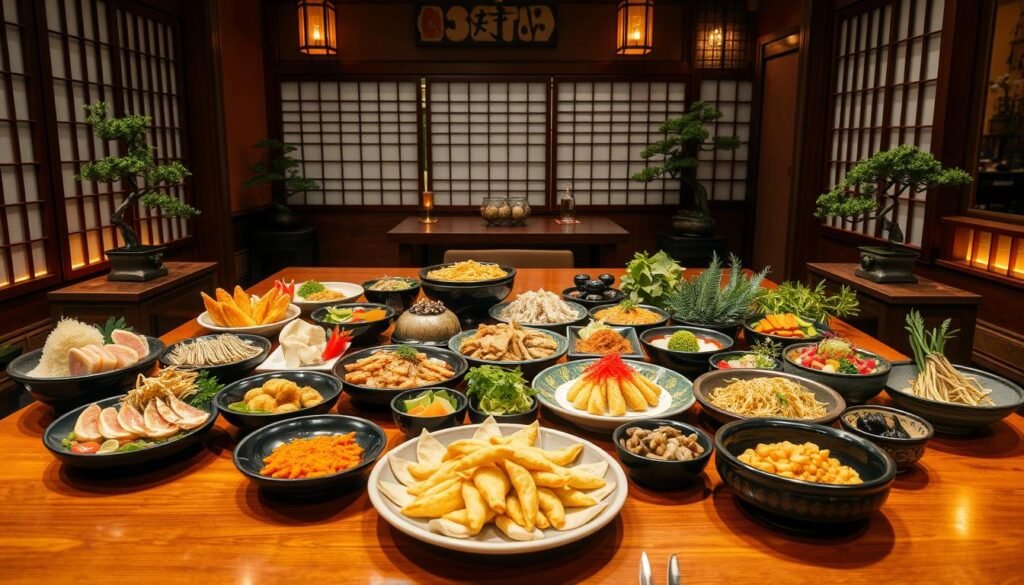
Spring Bento Essentials
When cherry blossoms bloom, lunchboxes turn into pink celebrations. Sakura mochi is a star – a sweet rice cake wrapped in pickled cherry leaves. It tastes like spring itself.
Tokyo’s Hamamatsucho district is a mochi paradise. Shops like Chomeiji use century-old recipes.
Sakura Mochi Wrapping Techniques
This iconic treat has two regional styles:
- Kanto-style: Smooth dough colored with red shiso leaves
- Kansai-style: Chunky rice grains steamed in bamboo leaves
Master wrappers use fresh leaves harvested just before peak bloom. They brush them with umezu (plum vinegar) to enhance their flavor.
Winter Comfort Classics
As snow blankets Hokkaido, locals enjoy soup curry. It’s a spicy broth with root vegetables and fall-off-the-bone meat. What makes it special? The broth thickens using roasted bone marrow instead of traditional roux.
Hokkaido Soup Curry Culture
Sapporo’s Susukino district is home to curry specialists like Suage+. Here, you:
- Choose your heat level (1-40!)
- Pick seasonal veggies
- Select from 12 bone broth bases
The dish evolved from 1970s student kitchens. It blends Indian spices with Russian stew techniques. Today, it’s winter’s ultimate comfort food – best enjoyed after skiing Shirakawa’s slopes.
Rainy Season Realities (June-July)
Traveling in Japan’s tsuyu season? June and July may be rainy, but they also bring surprises. People enjoy the hydration of rice paddies and the vibrant hydrangeas. These flowers show that even gray skies can’t stop Japan’s beauty.
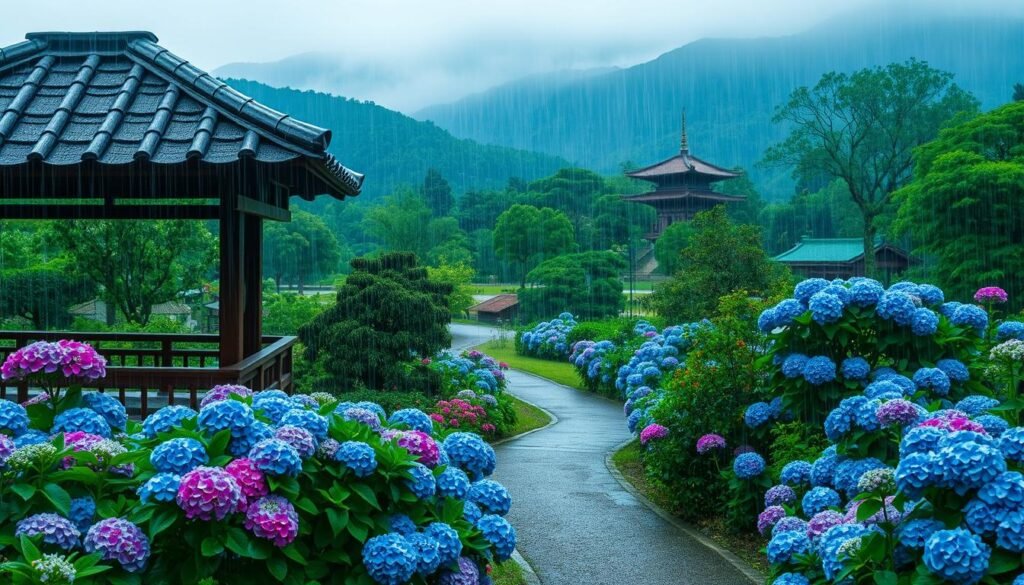
Hydrangea Viewing Silver Linings
Trade cherry blossoms for ajisai (hydrangeas) in rainy season Japan. Kamakura’s Hase-dera Temple is a floral paradise with over 2,500 blooms. For a secret spot:
- Hike Hakone’s hydrangea-lined Old Tokaido Road
- Visit Meigetsu-in Temple’s “Hydrangea Shrine” in Kamakura
- Join locals making ajisai ame (flower-shaped candies)
Indoor Alternatives
When it rains, Japan’s cities are a delight. Tokyo’s teamLab Planets turns rain into digital art. You can walk through virtual waterfalls without getting wet. Other great indoor spots:
- Osaka’s Kaiyukan Aquarium (watch whale sharks glide overhead)
- Kyoto samurai sword workshops
- Underground “depachika” food halls for seasonal treats
Snow Country Adventures
Japan’s winter turns into a playground for those who love adventure and culture. Ski resorts are popular, but the real magic is in the snow-covered forests and hidden trails. These places become magical under the snow.
Backcountry Skiing Frontiers
Myoko Kogen is Japan’s top spot for backcountry skiing. It offers deep powder and open bowls. Local guides take skiers to secret spots like Seki Onsen’s steep chutes.
Zao is famous for its “snow monsters,” ice-covered trees that look like giants. In Hokkaido, helicopter skiing in Daisetsuzan National Park is a thrilling experience. It drops skiers on remote peaks for endless descents.
- Guided safety: Always hire certified guides for avalanche-prone areas
- Gear up: Rent fat skis or splitboards at local shops
- Après-ski soak: Natural hot springs like Nozawa Onsen soothe sore muscles
Snowshoe Temple Explorations
Yamagata’s Yamadera Temple is a winter wonderland. Snowshoeing up its path reveals frozen waterfalls and red gates covered in snow. The top offers stunning views of the valley.
In Shiga Kogen, the Yokotuji Shrine offers moonlight snowshoe tours. Visitors walk through snow-covered groves to find hidden Buddha statues.
“Trekking through temple snow feels like walking through a living ink painting – every step reveals new poetry.”
| Location | Feature | Best Month |
|---|---|---|
| Yamadera | Historic stone paths | January |
| Koyasan | Okuoin Cemetery trail | February |
| Hakusan | Sacred peak ascent | March |
Festival Calendar Masterclass
Japan’s festival calendar is full of energy all year. But, travelers looking for something special should explore beyond the famous events. Kyoto’s Gion Matsuri gets a lot of attention, but there are many other festivals and traditions that are just as amazing.
Regional Gems Beyond Gion Matsuri
Trade in the crowds for these lively local festivals:
- Tokushima’s Awa Odori (August 12-15): Join 1.3 million dancers in “the fools’ dance”. Streets come alive with dancing and paper lanterns.
- Aomori Nebuta Matsuri (August 2-7): See giant warrior floats light up the night. The sound of taiko drums is unforgettable.
- Akita Kanto Matsuri (August 3-6): Watch performers balance 46-foot bamboo poles with 46 lanterns. It’s a skillful display in northern Japan.
Pro tip: Many festivals happen during rice planting (May) or harvest (September). Ask locals for the best times to see these festivals without the crowds.
Obon Season Travel Strategies
Mid-August’s Obon holiday brings 80 million Japanese home. Here’s how to navigate the chaos:
- Book Shinkansen tickets 3 months early on JR East’s English site
- Avoid August 13-15 for the biggest crowds. Travel August 8-12 or 16-20 instead.
- Visit southern islands like Yakushima. It’s much less crowded than mainland cities.
“Obon isn’t just about travel chaos. It’s when ancestral spirits visit. Join bon odori dances in local parks for a spiritual experience.”
Plan your trip to combine festivals with cultural experiences. Visit Takayama in October for the Hachiman Matsuri and see the autumn leaves. Or go to Sapporo in February for the Snow Festival and skiing.
Seasonal Travel Etiquette in Japan
Traveling in Japan means more than just knowing when to go. It’s about understanding the culture. Enjoy cherry blossom picnics and snowy hot springs by knowing the local customs.
Hanami Party Protocols
In Tokyo, cherry blossom parties fill parks with people. Places like Ueno Park and Shinjuku Gyoen need reservations. Here’s how to do it right:
- Book spots online (1-2 weeks before)
- Arrive on time to keep your spot
- Use small tarps to avoid crowding
Remember, leave no trace. Bring your own trash bags. Public bins might not be around.
Onsen Winter Manners
Hot springs in the snow are magical. But, you must follow the rules. Here’s what to do in winter:
| Do’s | Don’ts | Why It Matters |
|---|---|---|
| Wash well before getting in | Don’t put towels in water | Keep the water clean |
| Dry off completely after | Be quiet | Keep it peaceful |
| Keep long hair up | Don’t rush | Respect the tradition |
In places like Hokkaido, watch for ice. Many places offer special sandals for safety.
Crafting Your Perfect Timeline
Smart travelers know Japan’s seasonal rhythm requires strategic planning. While cherry blossoms and autumn leaves steal headlines, savvy visitors use calendar tricks to balance iconic experiences with crowd-free moments.
Shoulder Season Sweet Spots
May and October are Japan’s secret weapons. These months deliver mild weather without peak season prices. In May:
- Hakone’s hydrangeas bloom after Golden Week crowds disperse
- Northern Alps hiking trails open with crisp mountain air
- Kyoto’s temples feel serene before summer humidity arrives
October brings fiery foliage to overlooked regions:
- Tohoku’s Oirase Gorge lights up with fewer photographers
- Shikoku’s Iya Valley reveals hidden vine bridges
- Nagasaki’s night views pair perfectly with cooling temperatures
“Arriving October 20th lets you chase koyo colors south to north like a leaf-peeping detective”
Peak Season Workarounds
When you must visit during busy periods, these hacks save the day:
- Fly into Fukuoka instead of Tokyo during Golden Week
- Book shukubo temple lodgings for Kyoto alternatives
- Use Japan’s punctual trains for day trips from major cities
For winter sports fans:
- Try Appi Kogen instead of Niseko for powder snow
- Visit Nagano’s snow monkeys mid-week
- Stay at lesser-known onsen towns like Nyuto Onsen
Early birds win at popular sites. Arrive at Fushimi Inari by 7 AM to photograph empty torii gates. Most tourists sleep in – use those golden morning hours wisely!
Your Seasonal Japan Journey Starts Here
Japan’s landscapes change with the seasons, each bringing its own magic. From Kyoto’s cherry blossom tunnels to Hokkaido’s snow, every season has its charm. This guide helps you plan your trip to see Japan’s best, whether it’s autumn colors in Nikko or summer festivals in Okinawa.
Planning your trip wisely can make the most of Japan’s weather. Visit temples in Kamakura or Nara during the shoulder seasons for fewer crowds. Mix city life with nature by seeing Tokyo’s lights and then relaxing in Nagano’s hot springs.
Want to create your perfect Japan trip? Our team can help plan your journey around the best times to see cherry blossoms, autumn leaves, and festivals. Just tell us what you’re looking for, and we’ll make a trip that fits Japan’s natural beauty. Which season will you start with?




